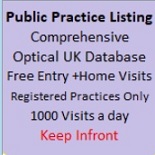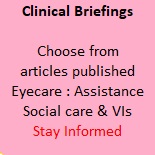General News
COVID-19 guidance for primary eye care services in England, Keep Calm and Carry On
COVID-19 guidance for primary eye care services in England, Keep Calm and Carry On
Following the publication of England’s COVID-19 summer 2021 and the Prime Minister’s follow-up statement on 12 July, the government has stated that health and care settings in England should continue to maintain appropriate infection prevention and control (IPC) measures. The Chief Medical and Chief Scientific advisers have also stated that the pandemic is not over and they expect an extremely high prevalence of COVID infections until at least the end of August.*, #
Optical sector bodies support the need to maintain robust IPC measures. We will continue to monitor updates to public health advice and support NHS England/Improvement (NHSEI) to update the Optical standard operating procedure as the situation evolves. Optical practices should therefore continue to follow the College’s Amber guidance and the NHSEI Optical SOP.
This means that on 19 July practices should continue to:
• follow current IPC guidance, including PPE
• ensure social distancing remains in place for optical settings
• maintain patient triage and prioritisation
• sanitise frames
• maintain good ventilation throughout the practice
These measures will help minimise the risk of COVID-19 transmission and give the public confidence that they can access eye care safely.
Patient use of face coverings and social distancing are the two areas that members have asked us to provide further information on and this is set out below.
Social distancing
The NHSEI SOP refers to the Health and Safety Executive (HSE) guidance on making your workplace COVID-secure. The HSE continues to advise that where possible you should keep people 2 metres apart. If this is not viable, keeping 1m apart with risk mitigation is acceptable.
Patients’ use of face coverings
The OC recommend that patients and the public should continue to wear face coverings when on practice premises and including when receiving eye care.
The NHSEI’s SOP advises that where a patient does not want to use a face covering you should take all reasonable steps to identify practical working solutions with the least risk to all involved. This involves undertaking a risk assessment which should consider, for example:
• request the patient wears a mask, for close contact care only in the test room or dispensing area
• booking the person into a quieter appointment slot or one in a separated area, or with another member of staff if the original staff member is at high risk or uncomfortable seeing patients without a mask
• providing care via a remote appointment supported within the GOC amended statements
If you have any questions, please contact your representative body. The optical bodies have also created FAQs to help with scenarios in which patients cannot or will not use a face covering.
Do practice staff still need to wear face masks?
Yes, all members of the practice team should continue to follow the IPC guidance and wear appropriate PPE, including the sessional use of fluid resistant surgical masks (FRSM).
Do I still need to sanitise sample frames after patients or customers have tried them on?
Yes
How can I promote ventilation?
Open doors and windows where possible and leave the consulting room door open between appointments. Ensure extractor fans are working and turned on in all areas of the practice.
What approach should I adopt in my practice to manage situations when a patient cannot or will not wear a face covering?
We recommend the following approach to ensure consistency across all practices in England.
• Ensure you have a clear and readily available policy that sets out your position on patients wearing face coverings within the practice and make patients aware of this in advance of appointments.
• This policy should set out how to provide eye care to people who cannot wear a face covering, by making reasonable adjustments.
• Ensure that policy is consistent with equalities legislation, and if you are unsure seek advice from your representative body.
• Ensure this policy explains that the practice is a healthcare setting and face covering use is recommended by the NHS for the benefit of all patients, and due to the prolonged close proximity that is required.
• If a person forgets their face covering, it is good practice to supply one for them to wear.
• If a person is unable, or declines, to wear a face covering the practice should follow a risk-based approach to determine whether and how they can meet the patient’s needs (see above).
• Wherever possible practices should try and accommodate all patients who are unable or who choose not to wear a face covering, to ensure every person has access to the eye care they need.
• If, as a result of individual risk assessments, there is no one in the practice team who is able to examine patients who are not wearing a face covering, the practice may be in a position where it is unable to meet that patient’s needs.
In this situation the practice should explain the situation and refer the patient to another local provider. You should keep a record of when you do this, and the reasons given to the patient. Having this arrangement in place locally should be agreed in advance with other local practices.
























